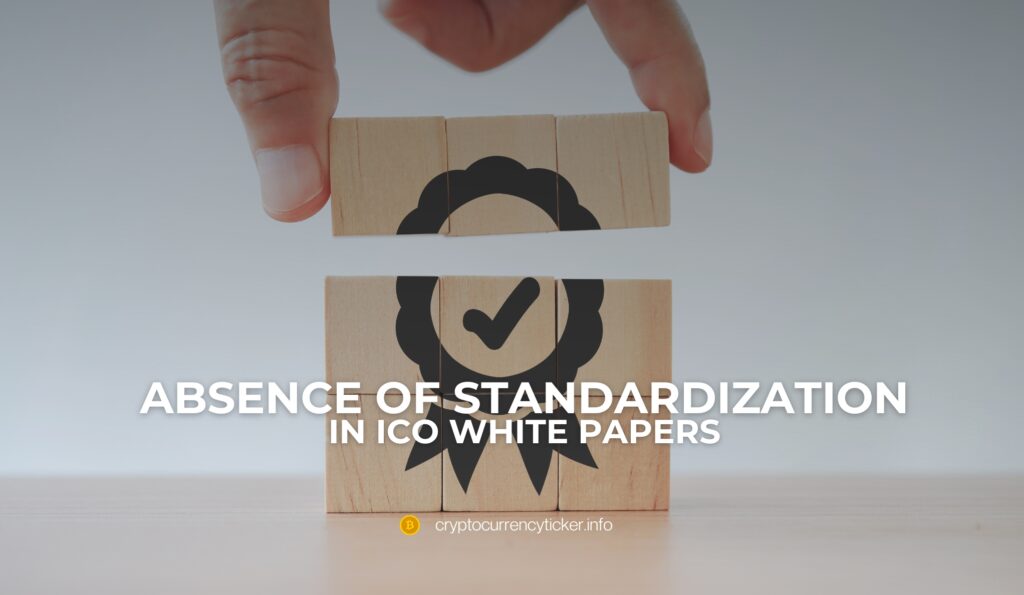Initial Coin Offerings (ICOs) represent a modern fundraising mechanism where new projects offer crypto tokens in exchange for investments, similar to Initial Public Offerings (IPOs) but with digital tokens. The success and transparency of these ICOs largely hinge on their white papers.
A white paper in the ICO context is a document that elaborates on the project’s vision, technology, and the specifics of the offered token. It’s the primary source of information for potential investors, reducing the information asymmetry between issuers and investors. These documents typically cover:
- Project Goals: Detailing the vision, technology behind the project, and its roadmap.
- Tokenomics: Explaining the economics of the token, distribution plans, and usage of funds.
- Legal Compliance: Often including disclaimers and risk disclosures due to the lack of standardized legal requirements for ICO white papers.
The evolution of ICO white papers reflects the maturing market. Initially focusing on technical aspects, modern white papers are now comprehensive, covering technical, market, and legal aspects. The quality of a white paper often indicates the project’s credibility and professionalism.
The Anatomy of an ICO White Paper
Understanding the structure and content of an ICO white paper is crucial for investors and stakeholders to assess the potential and viability of a cryptocurrency project. An ICO white paper typically follows a structured format, although there is no universal template. Each section plays a significant role in presenting the project comprehensively.
Key Components of an ICO White Paper:
- Executive Summary: This section provides an overview of the ICO, encapsulating the project’s essence, objectives, and unique selling points. It’s designed to capture the reader’s interest and give a snapshot of what the project entails.
- Market Analysis: This part delves into the market need for the project. It includes industry analysis, target market identification, and a discussion on how the project addresses existing problems or gaps in the market.
- Project Description: Here, the white paper details the project’s vision, mission, and goals. It often includes the project’s history, its current status, and future plans.
- Technology Overview: Essential for tech-based ICOs, this section explains the technology behind the project, including technical specifications, architecture diagrams, and development progress. It should be detailed enough for tech-savvy readers while remaining accessible to general investors.
- Tokenomics: This crucial section covers the economics of the token. It details the total supply of tokens, distribution plans, pricing strategy, and how the funds raised will be allocated. Understanding this section helps investors gauge the potential value and utility of the token.
- Roadmap: The roadmap outlines the project’s developmental milestones, including past achievements and future goals with estimated timelines. It provides a timeline of the project’s vision, indicating the team’s commitment and planning acumen.
- Team and Advisors: A section dedicated to introducing the team behind the project and their credentials. It often includes information about the advisory board, highlighting their expertise and how they contribute to the project.
- Legal Considerations and Compliance: Given the regulatory uncertainties in the crypto space, this part addresses the legal aspects, including compliance with relevant laws and regulations, and any legal risks associated with the project.
- Risk Factors: This section outlines potential risks associated with the project, providing a realistic picture of challenges and uncertainties.
- Conclusion: A final summary that reiterates the project’s value proposition and calls to action, often inviting readers to participate in the ICO or follow the project’s progress.
Evaluating the Information Quality of White Papers

The information quality of an ICO white paper is a critical factor in determining the potential success and credibility of the cryptocurrency project. Investors rely heavily on these documents for in-depth understanding and assessment. Therefore, evaluating the content and depth of information provided in white papers is essential.
Criteria for Assessing White Paper Quality:
- Clarity and Comprehensiveness: The white paper should clearly articulate the project’s vision, technology, and goals. It should be comprehensive, covering all aspects of the project, including market analysis, technology, tokenomics, and legal considerations.
- Technical Detailing: For technology-driven projects, the depth of technical information is crucial. This includes detailed descriptions of the technology, use cases, and any innovations. Complex concepts should be explained in a way that is understandable to both technical and non-technical readers.
- Realistic Projections and Roadmap: The roadmap and projections should be realistic and achievable. Overly optimistic timelines or unfounded claims can be red flags. Historical progress and future milestones should be clearly outlined.
- Legal Compliance and Transparency: Given the regulatory landscape of ICOs, the white paper should address legal considerations and compliance with relevant jurisdictions. Transparency in terms of risks and legal aspects is a sign of credibility.
- Team Expertise and Experience: The background and expertise of the team and advisors can significantly impact the project’s success. A reputable team with relevant experience adds to the white paper’s credibility.
- Market and Industry Analysis: A thorough analysis of the market and industry shows that the team has a deep understanding of the environment in which they operate. It should include target market, competitors, and SWOT analysis (Strengths, Weaknesses, Opportunities, Threats).
Analyzing the White Paper’s Impact:
- Length and Complexity: Research suggests that the white paper’s length and text complexity can be correlated with ICO success. However, length should not compromise clarity and conciseness.
- Transparency and Detailing: Detailed and transparent white papers are more likely to gain investor trust. This includes clear explanations of token distribution, use of funds, and project feasibility.
Legal and Regulatory Perspectives of White Papers in ICOs
The legal and regulatory framework surrounding ICOs, particularly pertaining to their white papers, is a complex and evolving area. Given the rapid growth of the cryptocurrency market and the innovative nature of ICOs, regulatory bodies worldwide are continually adapting their approaches. This section explores the legal considerations and compliance aspects critical to ICO white papers.
Absence of Standardization in White Papers:

- Lack of Legal Requirements: Unlike traditional financial documents, there is no standardized legal framework or formal requirement for the content of ICO white papers. This lack of standardization presents both opportunities for innovation and challenges in ensuring compliance and investor protection.
- Varying Jurisdictional Regulations: Different countries have varying regulations regarding cryptocurrencies and ICOs. It’s crucial for ICOs to navigate these legal landscapes and ensure compliance with the regulatory requirements of the jurisdictions they operate in or target.
Legal Considerations for ICO White Papers:
- Disclosure of Risks: A comprehensive white paper should include a section on risk factors, detailing the potential risks associated with the project, including market risks, technological risks, and regulatory risks.
- Intellectual Property Rights: Clarification of intellectual property (IP) rights, especially if the ICO involves proprietary technology or innovations, is essential.
- Anti-Money Laundering (AML) and Know Your Customer (KYC) Compliance: ICOs must address how they comply with AML and KYC regulations, which are crucial for preventing illegal activities such as money laundering and terrorism financing.
- Securities Law Compliance: Depending on the nature of the token and its utility, ICOs may need to comply with securities laws. The classification of tokens as securities can have significant legal implications.
- Consumer Protection: Ensuring that the white paper does not contain misleading information and adequately informs investors about the project and the use of funds aligns with consumer protection laws.
The Evolving Regulatory Landscape:
- Global Regulatory Shifts: As the ICO market matures, regulatory bodies worldwide are increasingly focusing on establishing guidelines and frameworks to protect investors and ensure market stability.
- Future Compliance Trends: The trend is moving towards greater transparency, accountability, and compliance. ICOs must be prepared to adapt to these changing regulations and ensure that their white papers reflect these requirements.
Smart Contracts and White Papers: A Technical Insight
In the realm of Initial Coin Offerings (ICOs), smart contracts play a fundamental role, serving as the backbone of these digital transactions. The integration of smart contracts into ICOs is a pivotal aspect, and their relationship with white papers is crucial for a comprehensive understanding of any ICO project. This section delves into the technical intricacies of smart contracts and how they are represented and explained in ICO white papers.
Understanding Smart Contracts in ICOs:

- Definition: A smart contract in the context of an ICO is a self-executing contract with the terms of the agreement between buyer and seller directly written into lines of code. These contracts are decentralized and run on a blockchain network, ensuring transparency and security.
- Functionality: Smart contracts automate the process of token distribution, fund collection, and other contractual obligations. They are programmed to execute automatically when predefined conditions are met, without the need for intermediaries.
Role of White Papers in Explaining Smart Contracts:
- Technical Descriptions: White papers typically contain detailed sections explaining the technical workings of smart contracts used in the project. This includes their architecture, functionality, and how they integrate with the blockchain platform.
- Security Features: Given the digital nature of ICOs, security is paramount. White papers should describe the security protocols and measures implemented in the smart contracts to prevent vulnerabilities and hacks.
- Compliance and Legal Aspects: White papers also discuss how smart contracts comply with legal requirements, especially in terms of executing financial transactions and handling investor funds.
- Use Cases: Demonstrating practical applications and use cases of smart contracts in the project helps investors understand their utility and functionality in real-world scenarios.
The Impact of Smart Contracts on ICO Success:
- Investor Confidence: Detailed and transparent information about smart contracts in white papers can significantly boost investor confidence. It demonstrates the project’s commitment to security and efficiency.
- Operational Efficiency: The automation and decentralization offered by smart contracts enhance operational efficiency, reducing costs and the potential for human error.
- Future Trends: As blockchain technology evolves, the complexity and capabilities of smart contracts are expected to grow. Future ICOs will likely feature more advanced and multifunctional smart contracts, a development that should be clearly communicated in white papers.
Future of ICOs and the Evolving Role of White Papers
The landscape of Initial Coin Offerings (ICOs) is continually evolving, influenced by technological advancements, regulatory changes, and shifting investor expectations. As the cryptocurrency market matures, the role of white papers in ICOs is also changing. This section explores the future trends and possibilities for ICOs and how white papers may adapt to meet new demands.
Predictions for the Future of ICOs:
- Increased Regulatory Scrutiny: As governments worldwide refine their cryptocurrency regulations, ICOs will likely face more stringent compliance requirements. White papers will need to address these regulations, potentially necessitating legal expertise.
- Security Token Offerings (STOs): STOs are gaining traction as ICOs backed by tangible assets and subject to securities regulations. White papers for STOs will need to conform to securities laws and provide clear information about asset backing.
- Deeper Technical Integration: With the emergence of more complex blockchain platforms and technologies, white papers may need to provide deeper technical insights to satisfy tech-savvy investors.
- Enhanced Transparency: Investors are increasingly seeking transparency and accountability. Future white papers may include real-time reporting of project progress and fund utilization through blockchain transparency.
- Globalization: ICOs are becoming more global, with projects attracting investors from diverse regions. White papers may need to cater to a global audience, potentially requiring translations and localization.
The Evolving Role of White Papers:
- Educational Tools: White papers will continue to serve as educational tools, explaining complex blockchain concepts and project details to potential investors.
- Due Diligence: They will remain a critical component of investor due diligence, helping investors assess project viability.
- Transparency and Trust: White papers will continue to be a means of building transparency and trust with the investor community.
- Marketing and Communication: White papers will also function as marketing and communication tools, promoting the project’s vision and value proposition.
Conclusion
In the realm of Initial Coin Offerings (ICOs), white papers are indispensable guides that bridge the gap between innovative blockchain projects and potential investors. These documents serve as vital sources of information, laying out a project’s vision, goals, and technology.
White papers go beyond information; they build trust by emphasizing transparency and accountability. They also serve as educational resources, making blockchain technology accessible to both technical and non-technical audiences.
As the cryptocurrency landscape evolves, white papers adapt to address regulatory, technical, and global challenges. Their quality significantly impacts ICO success, with well-structured, informative, and compliant white papers attracting investors and setting the stage for project success.
